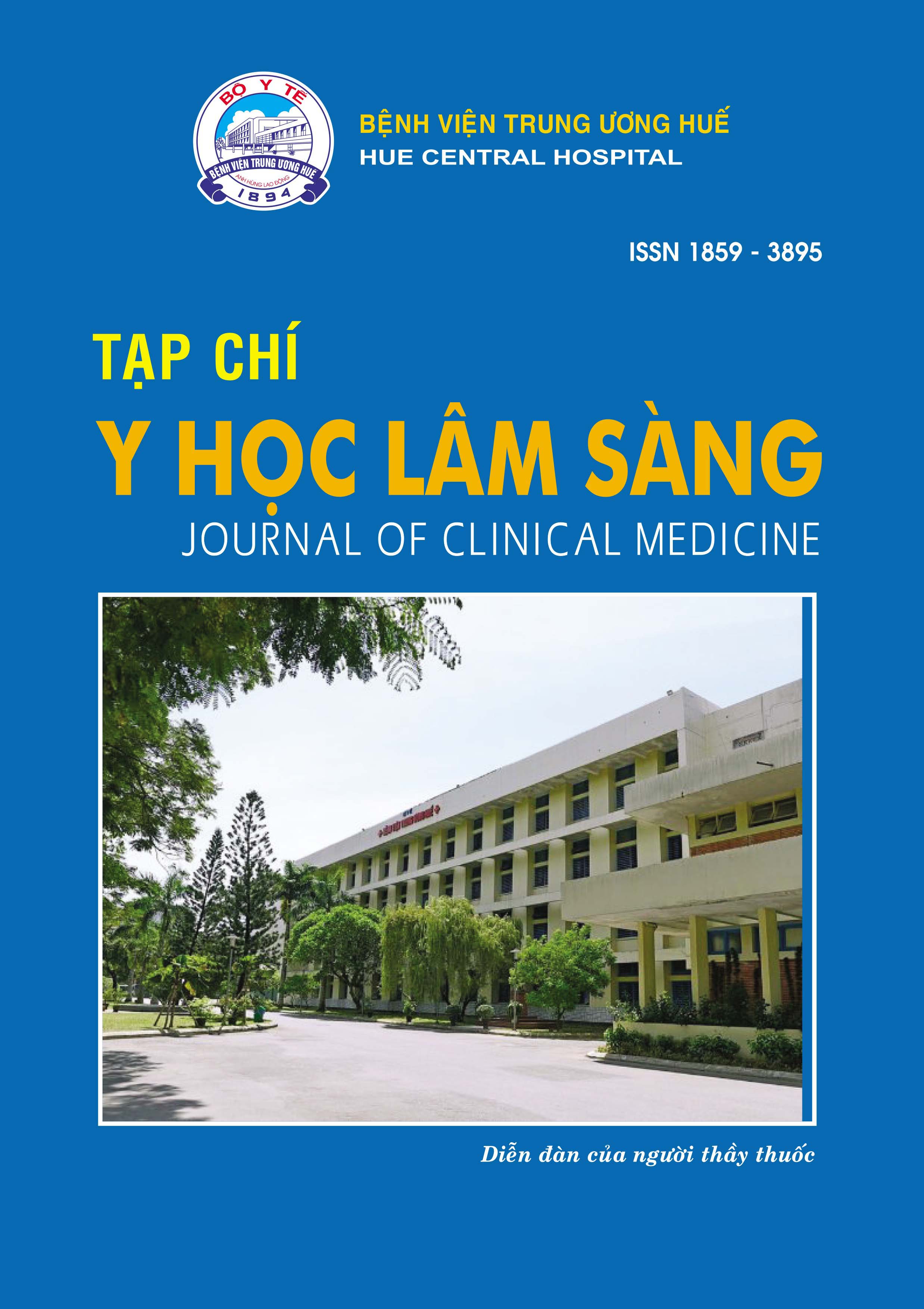Abstract
Objective: To assess some clinical, paraclinical chacteristics in patients with intermediate coronary stenosis.
Method: Cross- sectional study, describe clinical and paraclinical characteristics of 100 patients with 151 intermediate stenosis of coronary arteries at Hue Central Hospital and analyze the correlations between those characteristics and the severity of the coronary artery lesions.
Results: The main risk factors for coronary artery disease in this group were hypertension (66%), dyslipidemia (53%) and diabetes(11%). Typical angina (74%) is the main clinical manifestion, most of chest pain at CCS 2 and 3. No electrocardiographic changes in 61% of cases, and no regional dyskinesia in 78% of cases.The average stenotic diameter is 57.27 ± 7.06%, the average stenotic area is 80.71 ± 7.51%, the average lesion length is 10.58 ± 5.40 mm. There was no correlation between the severity of the stenosis and the characteristics of chest pain, the grade of chest pain based on CCS, and electrocardiographic changes or regional dyskinesia.
Conclusion: Characteristics of angina, echocardiography, electrocardiogram did not play a significant role in assessing myocardial ischemia in patients with intermediate coronary artery stenosis.
References
Huỳnh Trung Cang (2014), “Nghiên cứu ứng dụng phân suất dự trữ lưu lượng động mạch vành trong can thiệp động mạch vành qua da”, Luận án Tiến sĩ Y học, ĐH Y Dược Thành phố Hồ Chí Minh.
Ngô Minh Hùng (2016), “Nghiên cứu hẹp động mạch vành mức độ trung gian bằng siêu âm nội mạch và phân suất dự trữ lưu lượng vành ở bệnh nhân bệnh mạch vành mạn tính”, Luận án tiến sĩ Y học, Đại học Y Dược Huế.
Ängerud K.H., Brulin C. (2013), “Longer prehospital delay in first myocardial infarction among patients with diabetes: an analysis of 4266 patients in the Northern Sweden MONICA Study”, BMC Cardiovascular Disorders, 13, pp.6.
Fihn SD, Gardin JM, Abrams J, Berra K et al. (2012), ACCF/AHA/ACP/AATS/PCNA/SCAI/ STS guideline for the diagnosis and management of patients with stable ischemic heart disease”, Circulation, 129(16), pp.e462.
Gould KL (2009), “Does Coronary Flow Trump Coronary Anatomy?”, JACC Cardiovasc Imaging, 2(8), pp.1009- 1023
Habib PJ, Green J, Butterfield RC et al.(2013), “Association of cardiac events with coronary artery disease detected by 64-slice or greater coronary CT angiography: a systematic review and meta-analysis”, Int J Cardiol, 169(2), pp.112–120.
H.K Kim, M.H Jeong (2012), “Atypical Presentation in Patients with Acute Coronary Syndrome”, Acute Coronary Syndromes , Dr. Mariano Brizzio (Ed.).
Mahmoodzadeh S,Moazenzadeh M et al. (2011), “Diagnostic performance of electrocardiography in the assessment of significant coronary artery disease and its anatomical size in comparison with coronary angiography”, J Res Med Sci, 16(6), pp. 750–755
Montalescot G, Sechtem U, Achenbach S, Andreotti F et al. (20113), “2013 ESC guidelines on the management of stable coronary artery disease: the Task Force on the management of stable coronary artery disease of the European Society of Cardiology”, Eur Heart J, 34(38); pp.2949-3003.
Nabel EG, Braunwald E (2012), “A tale of coronary artery disease and myocardial infarction”, N Engl J Med, 366, pp.54-63.
Renker M et al. (2015), “Imaging coronary artery disease and the myocardial ischemic cascade: clinical principles and scope”, Radiol Clin North Am, 53(2), pp.261-v269
Smits PC et al. (2017), “Fractional flow reserveguided multivessel angioplasty in myocardial infarction”, N Engl J Med, 376, pp.234-1244
T. Hiroaki et al. (2015), “Severity of morphological lesion complexity affects fractional flow reserve in intermediate coronary stenosis”, J Cardiol, 66(3), pp.239 – 245
Weleh R.D. (2001), “Prognostic value of a normal or nonspecific initial electrocardiogram in acute myocardial infarction”, JAMA, 286(16), pp.1977- 1984.
Wijntjens G.W.M et al.(2015), “Physiological assessment of coronary stenosis: a view from the coronary microcirculation”, Interv. Cardiol, 7(4), pp.401-413.
World Health Organization(2012), “Cardiovascular Disease: Global Atlas on Cardiovascular Disease Prevention and Control”, Geneva, Switzerlan.
Yong SC et al. (2011), “Three-dimensional and two-dimensional quantitative coronary angiography, and their prediction of reduced fractional flow reserve”, European Heart Journal, 32, pp.345–353.

This work is licensed under a Creative Commons Attribution-NonCommercial-NoDerivatives 4.0 International License.
Copyright (c) 2025 Journal of Clinical Medicine Hue Central Hospital

